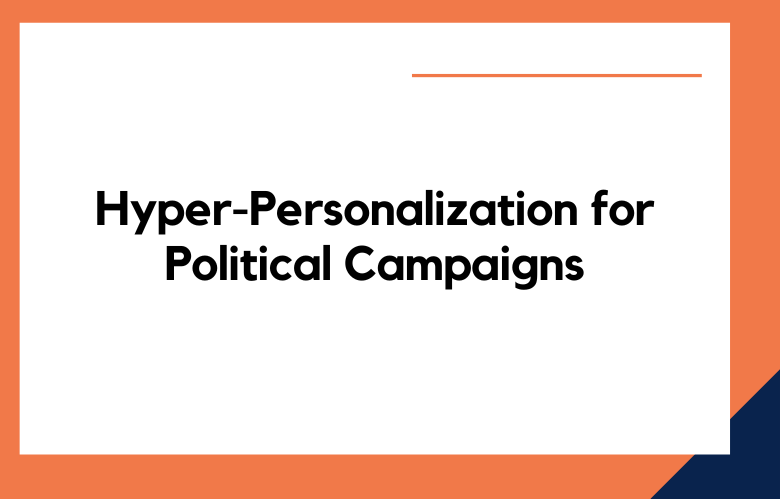In the era of social media and big data, traditional campaign strategies are no longer enough to win elections. With the rise of technology, political campaigns are changing, and hyper-personalization is becoming the new norm.
Hyper-personalization involves leveraging data and technology to tailor campaign messages and target each voter individually. We’ll dive into what hyper-personalization means, how it can benefit political campaigns, and what challenges campaigns face when implementing it.
Hyper-personalization means using data to create a tailor-made experience for each voter. Campaigns use data from voting history, social media, and other sources to determine which campaign messages and issues are most relevant to each voter. They can then deliver highly targeted ads, emails, and other notifications to each voter based on their interests and values.
How Hyper-Personalization is Revolutionizing Political Campaigns
Political campaigns are no longer about sending mass emails and hoping for a response. In today’s technology-driven world, campaigns use hyper-personalization to reach voters more effectively.
Hyper-personalization is the ability to target specific individuals with tailored campaigns based on their behaviors, preferences, and demographics.
It can motivate voters, increase donations, and even sway undecided voters. We will explore how hyper-personalization is revolutionizing political campaigns and changing how candidates interact with potential voters.
The Power and Potential of Hyper-Personalization in Political Campaigns
The gap between personal and professional communication is rapidly diminishing as the world continues to embrace digitization. With increasing access to technology, individuals have become more receptive to personalized touch, and the political sector is not left behind.
Hyper-personalization, a data-driven communication strategy, has become the latest buzzword in politics. This marketing technique helps campaigns create tailored messages for smaller target groups, resulting in better engagement, fundraising, and voter turnout.
I will explore hyper-personalization for political campaigns, its benefits, challenges, ethical considerations, and how it might influence future elections.
Using Hyper-Personalization to Win Political Campaigns
Political campaigns are full of complex strategies and methods that candidates can use to win voters’ trust and secure their votes. As the world embraces technological advancements, campaigns also turn to hyper-personalization to fine-tune their messages and reach their audiences.
Hyper-personalization takes data mining and microtargeting to the next level by creating highly personalized campaigns catering to individuals’ interests and beliefs. We’ll explore how hyper-personalization can help candidates win elections and the tools they can use to achieve this.
Hyper-Personalization in Political Campaigns
Hyper-personalization is breaking down your message to meet the individual’s tastes. In electoral campaigns, this means using data to understand who voters are, what they care about, and what motivates them. Candidates can identify the channels that each voter uses, preferred times of day to engage, and messages that resonate most with them.
A quick case study is the 2012 Obama campaign. The team leveraged data analytics to micro-target voters based on their interests, communication preferences, and voting behavior. Through email newsletters, social media platforms, and website visits, the campaign reached out to millions of potential voters, made millions of donations, and got millions to vote.
Understanding Hyper-Personalization
Hyper-personalization uses data to gather insights about voters’ preferences, lifestyles, and consumption patterns.
This data is analyzed using algorithms to identify the most suitable messages and channels the candidate can use to reach them. Depending on their past behaviors, this could include sending tailored emails, ads, or even SMS messages to a voter.
Hyper-Personalization Tools
Hyper-personalization can be time-consuming, complex, and hard to execute, but thanks to technology, it has become more accessible than ever before. There are plenty of tools available for campaigns that want to take advantage of hyper-personalization, such as:
NGP VAN helps campaigns organize data and target voters more effectively.
Optimizely is a tool that helps campaigns test and optimize their websites and landing pages for each visitor.
Civis Analytics is a data science firm that offers tools for campaigns to analyze data and develop personalized outreach strategies.
Advantages of Hyper-Personalization
Hyper-personalization offers several advantages for political campaigns, such as:
Increased engagement:
By sending personalized messages to voters, campaigns can increase engagement rates and build meaningful connections with their supporters.
Enhanced voter targeting:
Hyper-personalization helps campaigns identify the voters most likely to support their candidate and target them with tailored messages that resonate with their values and aspirations.
Maximum impact:
By tailoring their messages and strategies, campaigns can ensure that every dollar spent on outreach has maximum impact and generates positive results.
Challenges of Hyper-Personalization
Of course, hyper-personalization is not without its challenges. Some of the common challenges that campaigns may face when implementing hyper-personalization include:
Privacy concerns:
Collecting and analyzing data about individuals may raise privacy concerns and make voters more hesitant about supporting a particular candidate.
Resource-intensive:
Developing a hyper-personalized campaign can be resource-intensive and require significant data analysis, technology, and staff investments.
Overcomplication:
There is also a risk that campaigns may overcomplicate their outreach strategies by creating too many segments and messages, confusing voters and resulting in inefficiencies.
Future of Hyper-Personalization in Politics
Hyper-personalization in politics is here to stay. With advances in big data analytics, machine learning, and artificial intelligence, political campaigns will continue to refine their personalization tactics in future elections. Predictive modeling and data-driven strategies will help candidates optimize their message for maximum impact while safeguarding privacy.
However, political platforms must recognize that personalization is only one tool in their arsenal. Balanced communication that engages with more significant issues of national importance and trust-building is critical to effective governance, social cohesion, and healthy democratic values.
Conclusion:
Hyper-personalization is the future of political campaigns. With its potential to significantly improve engagement and voter turnout, campaigns must up their game by leveraging technology to create personalized messaging.
However, campaigns must respect voters’ votes’ privacy and use data responsibly. While it may be challenging to implement hyper-personalization, the benefits of successful implementation are too significant to ignore.
By embracing hyper-personalization, campaigns can create an authentic, personalized connection with voters and increase their chances of winning elections.
Call: +91 9848321284
Email: [email protected]











